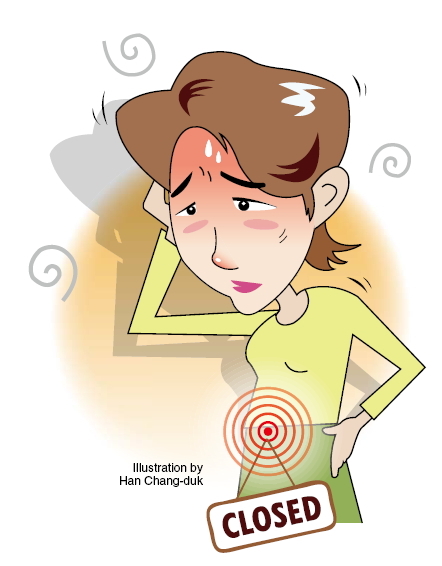
Following hormone and bone density tests, she was diagnosed with premature menopause. She was found to have reduced bone density and increased cholesterol. Ms. K was told that the symptoms she had, such as facial flushing, perspiration, insomnia and arthritis, were due to insufficient female hormones, and so she underwent hormone therapy. Her symptoms improved with the therapy and light cardio exercise, and she is now receiving regular treatment and tests.
Menopause usually occurs around 51 years old and is a result of the ovarian follicles, or eggs, running out. Premature menopause is menopause around 40 years old, and it is found in 1 percent of all women. It is an important condition that contributes to 10-28 percent of amenorrhea, or the absence of menstrual bleeding.
The ovaries play an important function by releasing mature follicles allowing pregnancy. It is also an endocrine organ that produces the female hormones estrogen and progesterone and the male hormone testosterone. The sex hormones play an important role in the genitourinary (urinary and reproduction) system, skin, bone tissue, cardiovascular and neurological systems. Therefore, those who experience menopause 10 years early can develop serious medical conditions related to aging, as well as becoming infertile.
Primary amenorrhea (when there has not been menarche or the first menstrual bleeding) is defined by an absence of periods by 14 years old with increased height and secondary sexual growth or 16 years old if there have been secondary sexual changes. Secondary amenorrhea is defined by an absence of three cycles of periods without being pregnant, with recent periods, or amenorrhea for six months. These patients need to be seen by a doctor, but if the symptoms are worrying they should see the doctor earlier. Premature menopause is diagnosed by increased gonadotrophins from the pituitary gland with reduced estrogen from the ovaries. Patients under the age of 30 years old should undergo chromosomal testing.
The follicular count is highest at 20 weeks of prenatal life at 6 million and reduces constantly until menopause. In most patients the exact cause of premature menopause is not known, but it is thought that genetic factors contribute to rapid reduction of follicles. The most well-known condition is Turner’s syndrome, which is associated with an abnormal karyotype, or profile of one’s chromosomes. Thyroid diseases, diabetes and autoimmune diseases can also cause this. In rare cases, viral infections can lead to the destruction of ovarian follicles, as well as radiotherapy or chemotherapy. In these patients, the pattern of amenorrhea varies from irregularly decreasing periods to a normal menstrual cycle depending on age and the number of remaining ovarian follicles.
The main issue with premature menopause is infertility and other problems that arise due to the deficiency of ovarian hormones, just like in normal menopause. The main symptoms include facial flushing, sleep disturbance, joint pain, headache, anxiety, depression and other psychiatric symptoms. The severity can be mild in primary amenorrhea. With time, skin aging and problems associated with urinary system atrophy can develop. After more than 10 years, there is an increased risk of osteoporosis and atherosclerosis.
The cause of premature menopause is not identified in most cases, and there is no prevention for it. When receiving radiotherapy, try to minimize the exposure to radiation, especially in the ovarian area. When undergoing chemotherapy it helps to minimize the use of drugs that are highly toxic for the ovaries. However it most cases it is difficult to avoid reduction of the number of follicles, so those who are considering becoming pregnant should think about freezing eggs before undergoing treatment.
In general, ovarian function does not return after the diagnosis of premature menopause is made. However, in patients with normal chromosomes who are diagnosed with premature menopause, ovarian function can return temporarily spontaneously or following estrogen treatment due to the remaining mature follicles. There have been cases of pregnancy naturally but this is very rare.
Patients can attempt ovulation-inducing therapy to treat infertility due to premature menopause, but most patients usually fall pregnant following egg donation. If pregnancy is not an issue, hormone replacement therapy can be used to prevent problems with hormone insufficiency. As stated earlier, the ovarian function can temporarily return, so patients with irregular periods during hormonal therapy must also use contraception. If there are no contraindications or risks of adverse reactions, oral contraceptives can be used. There are some patients who can have significant increased risk of breast cancer with the use of hormonal therapy for premature menopause; however, in other patients hormone therapy is mandatory to prevent serious conditions such as osteoporosis, arthrosclerosis and urinary system atrophy due to the early cessation of the production of ovarian hormones. Recent reports on thrombosis in the coronary or cerebral arteries were done on white, elderly women who already had atherosclerosis, but these results should be interpreted with caution. Women who are on hormone replacement therapy should see their doctors regularly to prevent possible side effects and make sure that they are still benefiting from the treatment.
Premature menopause is a relatively common condition. There can be significant mental and physical pain from the loss of ovarian function so it is important that the patients understand the condition and its causes. Specialized and tailored treatment based on this can help these women have a normal life.

By Yoon Byung-koo
The author is a doctor in the Department of Obstetrics and Gynecology at Samsung Medical Center and a professor at Sungkyunkwan University School of Medicine. ― Ed.
The author is a doctor in the Department of Obstetrics and Gynecology at Samsung Medical Center and a professor at Sungkyunkwan University School of Medicine. ― Ed.








![[Graphic News] More Koreans say they plan long-distance trips this year](http://res.heraldm.com/phpwas/restmb_idxmake.php?idx=644&simg=/content/image/2024/04/17/20240417050828_0.gif&u=)
![[KH Explains] Hyundai's full hybrid edge to pay off amid slow transition to pure EVs](http://res.heraldm.com/phpwas/restmb_idxmake.php?idx=644&simg=/content/image/2024/04/18/20240418050645_0.jpg&u=20240419100350)





![[From the Scene] Monks, Buddhists hail return of remains of Buddhas](http://res.heraldm.com/phpwas/restmb_idxmake.php?idx=652&simg=/content/image/2024/04/19/20240419050617_0.jpg&u=20240419175937)

![[KH Explains] Hyundai's full hybrid edge to pay off amid slow transition to pure EVs](http://res.heraldm.com/phpwas/restmb_idxmake.php?idx=652&simg=/content/image/2024/04/18/20240418050645_0.jpg&u=20240419100350)

![[Today’s K-pop] Illit drops debut single remix](http://res.heraldm.com/phpwas/restmb_idxmake.php?idx=642&simg=/content/image/2024/04/19/20240419050612_0.jpg&u=)